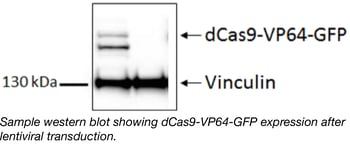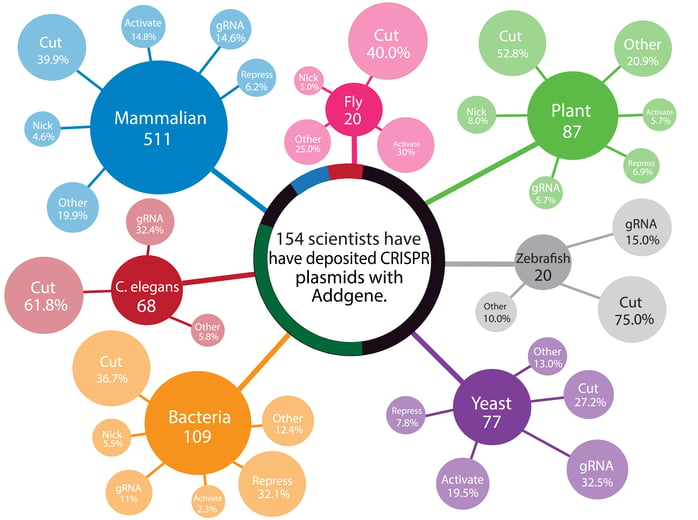Numbers in the large colored circles are rough approximations of the total number of CRISPR plasmids for that particular organism available at Addgene. Percentages represent the fraction of that total with the indicated function.
One huge reason CRISPR has become such a popular genome editing tool is its developers’ willingness to make their CRISPR technologies available to the academic research community. At Addgene, we’ve helped distribute many of these technologies in plasmid form and are proud to have facilitated their fast adoption. However, in many cases the plasmids themselves are only the starting point for the production of viruses used to deliver CRISPR components to cells or organisms under study. In the past we’ve left the arduous task of virus production to individual labs, but now we’re very excited to provide ready-to-use CRISPR lentiviral preps to researchers across the globe.
Why provide CRISPR as virus?
 “Like all things in science, getting a high titer Cas9 lentivirus prep takes a bit of time and effort that, for many groups, may not be worthwhile. Particularly if in the end all they want to do is to quickly generate a single cell line and proceed to use it for experiments.”
“Like all things in science, getting a high titer Cas9 lentivirus prep takes a bit of time and effort that, for many groups, may not be worthwhile. Particularly if in the end all they want to do is to quickly generate a single cell line and proceed to use it for experiments.”
- Alex Chavez, researcher at the Wyss Institute for Biologically Inspired Engineering and member of the Addgene Advisory board, on the difficulty of producing CRISPR lentivirus.
As we’ve heard from scientists, producing lentivirus is not always an easy process. The cloning capacity of lentiviral vectors (~8.5 kb of insert) and the reduced titer associated with large inserts can make lentivirus production frustrating - a researcher can complete an entire lentiviral production protocol only to find that the low titer of her prep makes it unuseable. With the large size of the SpCas9 nuclease (~4.2 kb) this is a particularly prominent problem in CRISPR genome editing experiments. We aim to alleviate this frustration by producing, titering, testing, and providing lentiviral preps of select lentiviral vectors from the repository for you. We perform test infections with all of our viral preps and host our expression data (western blots or fluorescent microscopy) on the material pages associated with each item.
 There are multiple CRISPR tools available as lentivirus and we’ll be adding more as the need arises. For example, we’ve teamed up with the Broad Institute to provide lentiviruses for delivery of SpCas9 and Cas9 nickase for genome editing. You can also enhance expression of your gene of interest with a variety of Cas9 activators available in lentiviral format. Finally, while we can’t currently produce custom gRNA-containing lentivirus, we are providing lentiviral preps containing highly requested gRNAs including those targeting EGFP, BRAF, and MAP3K4. The gRNAs targeting EGFP can be used as positive controls for gene editing or gene activation, while the BRAF and MAP3K4 gRNAs allow you to target these widely studied signalling pathways.
There are multiple CRISPR tools available as lentivirus and we’ll be adding more as the need arises. For example, we’ve teamed up with the Broad Institute to provide lentiviruses for delivery of SpCas9 and Cas9 nickase for genome editing. You can also enhance expression of your gene of interest with a variety of Cas9 activators available in lentiviral format. Finally, while we can’t currently produce custom gRNA-containing lentivirus, we are providing lentiviral preps containing highly requested gRNAs including those targeting EGFP, BRAF, and MAP3K4. The gRNAs targeting EGFP can be used as positive controls for gene editing or gene activation, while the BRAF and MAP3K4 gRNAs allow you to target these widely studied signalling pathways.
Find Validated gRNAs to use with your Cas9 Virus
Pooled libraries now available in lentiviral format
![]() Another popular set of tools in the repository are CRISPR pooled gRNA libraries that can be used to screen for genes involved in a wide variety of cellular processes. While these are widely requested and incredibly useful tools, they require extensive background work from the requesting scientist for their proper use; after receiving a pooled gRNA library in plasmid format, a researcher must amplify the library, use next-generation sequencing to ensure that the library has retained gRNA representation, produce high titer lentivirus from the library, ensure gRNA representation in the viral prep, infect target cells, and, finally, conduct the screen.
Another popular set of tools in the repository are CRISPR pooled gRNA libraries that can be used to screen for genes involved in a wide variety of cellular processes. While these are widely requested and incredibly useful tools, they require extensive background work from the requesting scientist for their proper use; after receiving a pooled gRNA library in plasmid format, a researcher must amplify the library, use next-generation sequencing to ensure that the library has retained gRNA representation, produce high titer lentivirus from the library, ensure gRNA representation in the viral prep, infect target cells, and, finally, conduct the screen.
To help alleviate some of this labor for our users, we now provide the Brunello (targeting human genes) and Brie (targeting mouse genes) pooled libraries from the labs of John Doench and David Root as ready-to-use lentiviral preps. Each library uses nearly 80,000 gRNAs to target around 20,000 individual genes. We provide enough lentivirus for you to both perform an optimization-scale infection and at least one screening-scale experiment achieving the gRNA representation recommended in the publications associated with these libraries. Please note, the pooled libraries we distribute in lentivirus format only deliver gRNA and therefore, must be used to infect a cell line already expressing Cas9.
As John Doench (Broad Institute and member of the Addgene Advisory Board) says:
 "When you're setting up to do a genetic screen, you need to focus on building a really good model that reflects the underlying biology you're interested in studying. You need to make sure your assay is scalable and robust. What you don't need to do is spend your time troubleshooting reagent production, because that's a distraction from your primary goal. Getting these quality-controlled reagents from Addgene can greatly expedite a researcher's ability to make discoveries."
"When you're setting up to do a genetic screen, you need to focus on building a really good model that reflects the underlying biology you're interested in studying. You need to make sure your assay is scalable and robust. What you don't need to do is spend your time troubleshooting reagent production, because that's a distraction from your primary goal. Getting these quality-controlled reagents from Addgene can greatly expedite a researcher's ability to make discoveries."
If you ever run out of ready-to-use virus and want to make new lentiviral preps on your own, fear not - anytime you order ready-to-use lentivirus from Addgene, you’ll also receive transfer plasmid DNA that you can use along with lentiviral packaging plasmids to create your own lentivirus stocks. Our research scientists have provided their standard lentivirus production protocol here and you can find more tips and protocols for working with lentivirus on our blog and protocol pages.
We’re excited to provide this new service for researchers wanting an easier way to use CRISPR and would love to hear from you if you have used or are thinking about using our viral services. Please send any questions or comments to help@addgene.org.
Finally we’d like to thank all those who are allowing us to distribute their CRISPR tools as ready-to-use virus and, in particular, the Church lab at the Wyss Institute for Biologically Inspired Engineering and the Zhang and Doench/Root labs from the Broad Institute for providing us with advice and expertise as we’ve gotten these services up and running. Both Alex Chavez and John Doench are members of the Addgene Advisory Board.
Additional Resources on the Addgene Blog
- Get the Most from Your Lentiviral Transdution
- Using Virus in Your Research: A Primer for Beginners
- 5 Tips for Troubleshooting Viral Transductions
Additional Resources on Addgene.org
- Visit the Viral Service Page
- Check Out Our CRISPR Guide Pages
- Find Viral Vectors
Topics: Viral Vectors, Addgene’s Viral Service








Leave a Comment